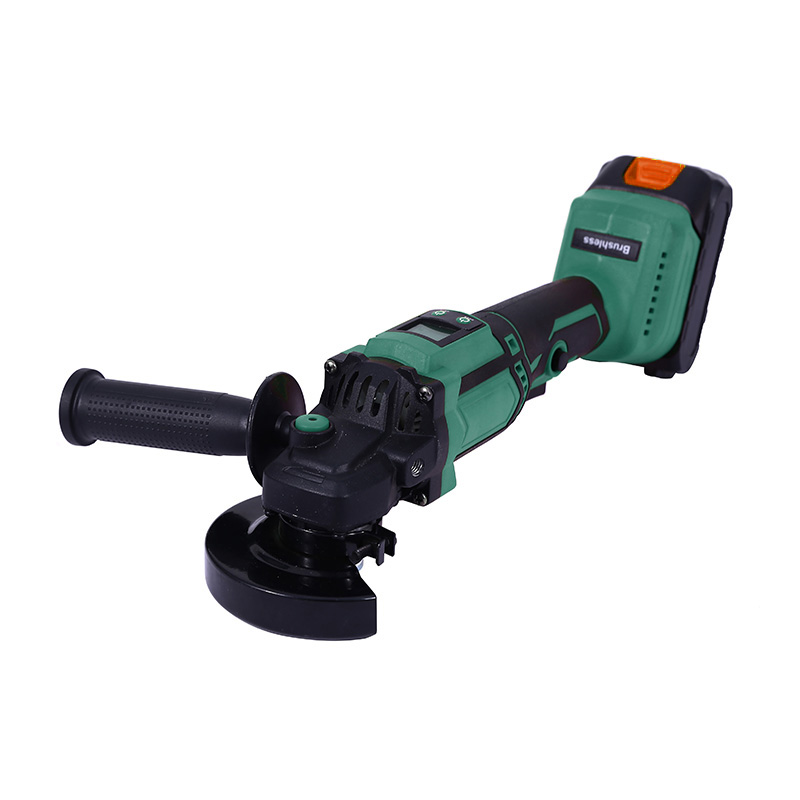Rechargeable angle grinders factory are portable power tools used for cutting, grinding, polishing, and finishing various materials, including metal, stone, and ceramics. Unlike corded grinders, they operate on rechargeable batteries, offering mobility and convenience in situations where access to electricity is limited. These tools have become increasingly common in workshops, construction sites, and home DIY projects.

1. Definition and Working Principle
Rechargeable angle grinders are compact devices equipped with a rotating disc or wheel that performs material removal through friction.
1.1 Core Components
Motor
The motor is responsible for spinning the grinding or cutting wheel. In cordless grinders, the motor is designed to operate efficiently at battery voltages, typically ranging from 12V to 36V. Brushless motors are often used to improve efficiency and reduce heat generation.
Battery
Rechargeable angle grinders rely on lithium-ion batteries, which provide portability and sufficient power for various tasks. These batteries are removable in most models, allowing users to swap a depleted battery with a charged one to continue work without interruption.
Disc/Wheel
Depending on the intended task, the grinder can be fitted with abrasive discs, diamond cutting wheels, or polishing pads. The disc speed and type of material used affect both the efficiency and safety of the operation.
1.2 Working Mechanism
When the battery supplies power to the motor, it rotates the attached disc at high speeds. The spinning disc creates friction against the workpiece, gradually removing material. Some grinders allow speed adjustment to accommodate delicate or heavy-duty tasks.
This mechanism enables users to perform a variety of operations with a single tool, enhancing flexibility in different environments.
2. Advantages and Limitations
Rechargeable angle grinders offer certain advantages over corded models, but they also come with practical limitations.
2.1 Advantages
Portability
Since there is no need for a power cord, these grinders can be used in remote locations or areas without immediate access to electricity. For example, maintenance personnel working on outdoor metal structures can operate the tool efficiently without running long extension cords.
Ease of Use
Lightweight battery packs reduce strain during extended operation. Users can maneuver the grinder into tight spaces or elevated positions more easily than with a corded device.
Quick Setup
There is no requirement for finding nearby outlets or managing cords. This is useful in construction or renovation projects where multiple work sites need to be accessed in sequence.
2.2 Limitations
Limited Operating Time
Battery life restricts continuous operation. For heavy-duty tasks, a single charge may not be sufficient, requiring spare batteries or intermittent recharging.
Lower Power Output
While adequate for light to medium tasks, cordless grinders may provide lower torque or speed compared to corded counterparts, making them less suitable for intensive grinding of large metal surfaces.
Battery Degradation
Lithium-ion batteries gradually lose capacity over time, affecting long-term usability and requiring eventual replacement.
3. Applications
Rechargeable angle grinders are versatile tools suitable for multiple professional and domestic uses.
3.1 Metalworking
Cutting, grinding, and shaping metal components in workshops or construction sites.
Removing rust or smoothing weld seams on machinery or structural components.
3.2 Masonry and Stonework
Cutting bricks, tiles, or small stone blocks for home renovations or landscaping.
Polishing stone surfaces in small-scale finishing work.
3.3 DIY and Home Projects
Furniture modification or restoration tasks, such as sanding or cutting small metal or wooden parts.
Quick repair jobs around the house where portability is crucial, such as trimming pipes or sharpening garden tools.
The wide application range demonstrates how rechargeable grinders can serve both professional and personal projects efficiently.
4. Selection Considerations
Choosing an appropriate rechargeable angle grinder requires evaluation of several factors.
4.1 Battery Capacity and Voltage
Higher voltage and larger battery capacity provide longer operation time and higher power output, suitable for heavy tasks. For example, a 36V grinder may handle metal cutting more effectively than a 12V unit.
4.2 Disc Size and Speed
Different disc diameters suit different operations: smaller discs offer better precision in tight areas, while larger discs can cover broader surfaces. Adjustable speed control further improves adaptability.
4.3 Safety Features
Features such as adjustable guards, anti-kickback mechanisms, and thermal protection are important to reduce risks during operation. A tool with integrated safety controls is particularly relevant for users working on uneven surfaces or in awkward positions.



 English
English русский
русский Español
Español







